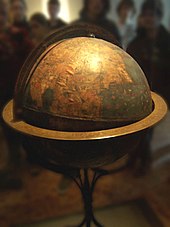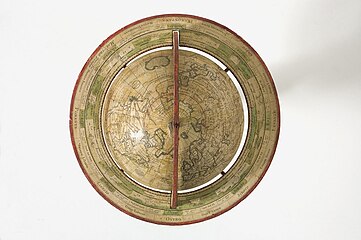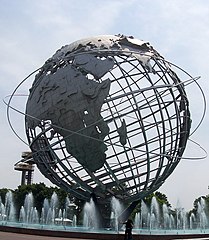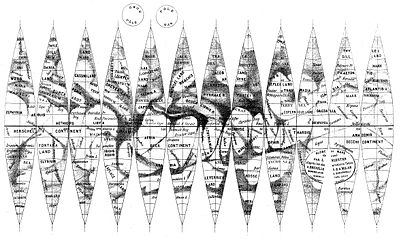Globe
A globe is a spherical model of Earth, of some other celestial body, or of the celestial sphere. Globes serve similar purposes to maps, but unlike maps, do not distort the surface that they portray except to scale it down. A globe of Earth is called a terrestrial globe. A globe of the celestial sphere is called a celestial globe.
A globe shows details of its subject. A terrestrial globe shows land masses and water bodies. It might show nations and prominent cities and the network of latitude and longitude lines. Some have raised relief to show mountains. A celestial globe shows stars, and may also show positions of other prominent astronomical objects. Typically it will also divide the celestial sphere up into constellations.
The word "globe" comes from the Latin word globus, meaning "sphere". Globes have a long history. The first known mention of a globe is from Strabo, describing the Globe of Crates from about 150 BC. The oldest surviving terrestrial globe is the Erdapfel, wrought by Martin Behaim in 1492. The oldest surviving celestial globe sits atop the Farnese Atlas, carved in the 2nd century Roman Empire.
Terrestrial and planetary
Flat maps are created using a map projection that inevitably introduces an increasing amount of distortion the larger the area that the map shows. A globe is the only representation of the Earth that does not distort either the shape or the size of large features – land masses, bodies of water, etc.
The circumference of the Earth is quite close to 40 million metres.[1][2] Many globes are made with a circumference of one metre, so they are models of the Earth at a scale of 1:40 million. In imperial units, many globes are made with a diameter of one foot, yielding a circumference of 3.14 feet and a scale of 1:41,777,000. Globes are also made in many other sizes.
Sometimes a globe has surface texture showing topography; in these, elevations are exaggerated, otherwise they would be hardly visible. Most modern globes are also imprinted with parallels and meridians, so that one can tell the approximate coordinates of a specific place. Globes may also show the boundaries of countries and their names.
Many terrestrial globes have one celestial feature marked on them: a diagram called the analemma, which shows the apparent motion of the Sun in the sky during a year.
Globes generally show north at the top, but many globes allow the axis to be swiveled so that southern portions can be viewed conveniently. This capability also permits exploring the earth from different orientations to help counter the north-up bias caused by conventional map presentation.
Celestial

Celestial globes show the apparent positions of the stars in the sky. They omit the Sun, Moon and planets because the positions of these bodies vary relative to those of the stars, but the ecliptic, along which the Sun moves, is indicated.
History

The sphericity of the Earth was established by Greek astronomy in the 3rd century BC, and the earliest terrestrial globe appeared from that period. The earliest known example is the one constructed by Crates of Mallus in Cilicia (now Çukurova in modern-day Turkey), in the mid-2nd century BC.
No terrestrial globes from Antiquity or the Middle Ages have survived. An example of a surviving celestial globe is part of a Hellenistic sculpture, called the Farnese Atlas, surviving in a 2nd-century AD Roman copy in the Naples Archaeological Museum, Italy.[3]
Early terrestrial globes depicting the entirety of the Old World were constructed in the Islamic world.[4][5] According to David Woodward, one such example was the terrestrial globe introduced to Beijing by the Persian astronomer, Jamal ad-Din, in 1267.[6]
The earliest extant terrestrial globe was made in 1492 by Martin Behaim (1459–1537) with help from the painter Georg Glockendon.[3] Behaim was a German mapmaker, navigator, and merchant. Working in Nuremberg, Germany, he called his globe the "Nürnberg Terrestrial Globe." It is now known as the Erdapfel. Before constructing the globe, Behaim had traveled extensively. He sojourned in Lisbon from 1480, developing commercial interests and mingling with explorers and scientists. In 1485–1486, he sailed with Portuguese explorer Diogo Cão to the coast of West Africa. He began to construct his globe after his return to Nürnberg in 1490.
Another early globe, the Hunt–Lenox Globe, ca. 1510, is thought to be the source of the phrase Hic Sunt Dracones, or “Here be dragons”. A similar grapefruit-sized globe made from two halves of an ostrich egg was found in 2012 and is believed to date from 1504. It may be the oldest globe to show the New World. Stefaan Missine, who analyzed the globe for the Washington Map Society journal Portolan, said it was “part of an important European collection for decades.”[7] After a year of research in which he consulted many experts, Missine concluded the Hunt–Lenox Globe was a copper cast of the egg globe.[7]
A facsimile globe showing America was made by Martin Waldseemueller in 1507. Another "remarkably modern-looking" terrestrial globe of the Earth was constructed by Taqi al-Din at the Constantinople Observatory of Taqi ad-Din during the 1570s.[8]
The world’s first seamless celestial globe was built by Mughal scientists under the patronage of Jahangir.[9]
Globus IMP, electro-mechanical devices including five-inch globes have been used in Soviet and Russian spacecraft from 1961 to 2002 as navigation instruments. In 2001, the TMA version of the Soyuz spacecraft replaced this instrument with a virtual globe.[10]
In the 1800s small pocket globes (less than 3 inches) were status symbols for gentlemen and educational toys for rich children.[11]
Manufacture
Traditionally, globes were manufactured by gluing a printed paper map onto a sphere, often made from wood.
The most common type has long, thin gores (strips) of paper that narrow to a point at the poles,[12] small disks cover over the inevitable irregularities at these points. The more gores there are, the less stretching and crumpling is required to make the paper map fit the sphere. This method of globe making was illustrated in 1802 in an engraving in The English Encyclopedia by George Kearsley [1].
Modern globes are often made from thermoplastic. Flat, plastic disks are printed with a distorted map of one of the Earth's Hemispheres. This is placed in a machine which molds the disk into a hemispherical shape. The hemisphere is united with its opposite counterpart to form a complete globe.
Usually a globe is mounted so that its spin axis is 23.5° from vertical, which is the angle the Earth's spin axis deviates from perpendicular to the plane of its orbit. This mounting makes it easy to visualize how seasons change.
Notable examples

- The Unisphere in Flushing Meadows, New York, at the Billie Jean King USTA Tennis Center, at 120 feet (36.6 m) in diameter, is the world’s largest geographical globe. (There are larger spherical structures, such as the Cinesphere in Toronto, Ontario, Canada, but this does not have geographical or astronomical markings.)
- Eartha, currently the world’s largest rotating globe (41 ft or 12 m in diameter), at the DeLorme headquarters in Yarmouth, Maine
- The Mapparium, three-story, stained glass globe at the Mary Baker Eddy Library in Boston, which visitors walk through via a 30-foot (9.1 m) glass bridge.
- The Babson globe in Wellesley, Massachusetts, a 26-foot-diameter (7.9 m) globe which originally rotated on its axis and on its base to simulate day and night and the seasons
- The giant globe in the lobby of The News Building in New York City.
- The Hitler Globe, also known as the Führer globe, was formally named the Columbus Globe for State and Industry Leaders. Two editions existed during Hitler’s lifetime, created during the mid-1930s on his orders. (The second edition changed the name of Abyssinia to Italian East Africa). These globes were “enormous” and very costly. According to the New York Times, “the real Columbus globe was nearly the size of a Volkswagen and, at the time, more expensive.” Several still exist, including three in Berlin: one at a geographical institute, one at the Märkisches Museum, and another at the Deutsches Historisches Museum. The latter has a Soviet bullet hole through Germany. One of the two in public collections in Munich has an American bullet hole through Germany. There are several in private hands inside and out of Germany. A much smaller version of Hitler’s globe was mocked by Charlie Chaplin in The Great Dictator, a film released in 1940.[13]
Gallery
-
19th Century projections of the terrestrial globe, from the UBC Library Digital Collections
-
Martin Behaim with his Erdapfel
-
Top view of 1765 de l'Isle globe
-
The Unisphere, attributed to "uribe"/Uri Baruchin
-
1594, Mechanised Celestial Globe
-
A Globus IMP navigation instrument from a Voskhod spacecraft.
-
Eartha, the largest rotating globe in the world.
-
A map of Mars that circulated commercially in the 19th century. It is an example of how maps are printed in order to be folded around a sphere to form a globe.
-
Multitouch spherical Globe with digital EARTH based on multitouch software
-
Globe as seen from space, Naturalis Biodiversity Center, Leiden (1998)
See also
- Analemma
- Armillary sphere
- Cartography
- Dymaxion map
- Emery Molyneux
- Globus Jagellonicus
- Google Earth
- Hunt–Lenox Globe
- NASA World Wind
- Johannes Schöner globe
- Orrery
- Planetarium
- Science On a Sphere
- Virtual globe
- Voskhod Spacecraft "Globus" IMP navigation instrument
- Ibrahim ibn Said al-Sahli
References
- ^ The Earth’s circumference is 40 million m because the metre was originally defined to be one 10-millionth of the distance between the poles and the equator.
- ^ Arc length#Arcs of great circles on the Earth
- ^ a b Microsoft Encarta Encyclopedia 2003.
- ^ Medieval Islamic Civilization By Josef W. Meri, Jere L Bacharach, pages 138–139
- ^ Covington, Richard (2007), "The Third Dimension", Saudi Aramco World, May–June 2007: 17–21, retrieved 2008-07-06
- ^ David Woodward (1989), "The Image of the Spherical Earth", Perspecta, 25, MIT Press: 3–15 [9], JSTOR 1567135
- ^ a b Kim, Meeri (2018-01-27). "Oldest globe to depict the New World may have been discovered". Washington Post.
- ^ Soucek, Svat (1994), "Piri Reis and Ottoman Discovery of the Great Discoveries", Studia Islamica, 79 (79), Maisonneuve & Larose: 121–142 [123 & 134–6], doi:10.2307/1595839, JSTOR 1595839
- ^ Society, National Geographic (2011-01-21). "globe". National Geographic Society. Retrieved 2017-01-23.
- ^ Tiapchenko, Yurii. "Information Display Systems for Russian Spacecraft: An Overview". Computing in the Soviet Space Program (Translation from Russian: Slava Gerovitch).
- ^ Bliss, Laura (13 October 2014). "These tiny glass globes were all the rage in London 200 years ago". Quartz (publication). Retrieved 2014-10-14.
- ^ "Image: globe.jpg, (450 × 100 px)". netpbm.sourceforge.net. Retrieved 2015-09-01.
- ^ "The Mystery of Hitler's Globe Goes Round and Round", by Michael Kimmelman, September 18, 2007. Accessed 2007-09-18.
External links
- ppmglobe – generate strips to glue onto a sphere
- 3D VRML globe
- 3D Java Globe with coastlines, parallels, meridians, etc.
- How to orient a globe in homothetic position to the Earth
- Glossary to World Globe Terms
- Behind the scenes at London's globe-making workshop – a photo essay (August 2017), The Guardian










